Hostas, also known as plantain lilies, are a gardener’s dream. Their lush foliage, shade tolerance, and low maintenance make them a staple in many gardens. With a wide variety of colors, sizes, and textures, hostas can transform any garden into a verdant paradise.
Here are 13 in-depth landscaping ideas to inspire you to incorporate hostas into your outdoor space.
1. Shady Garden Oasis


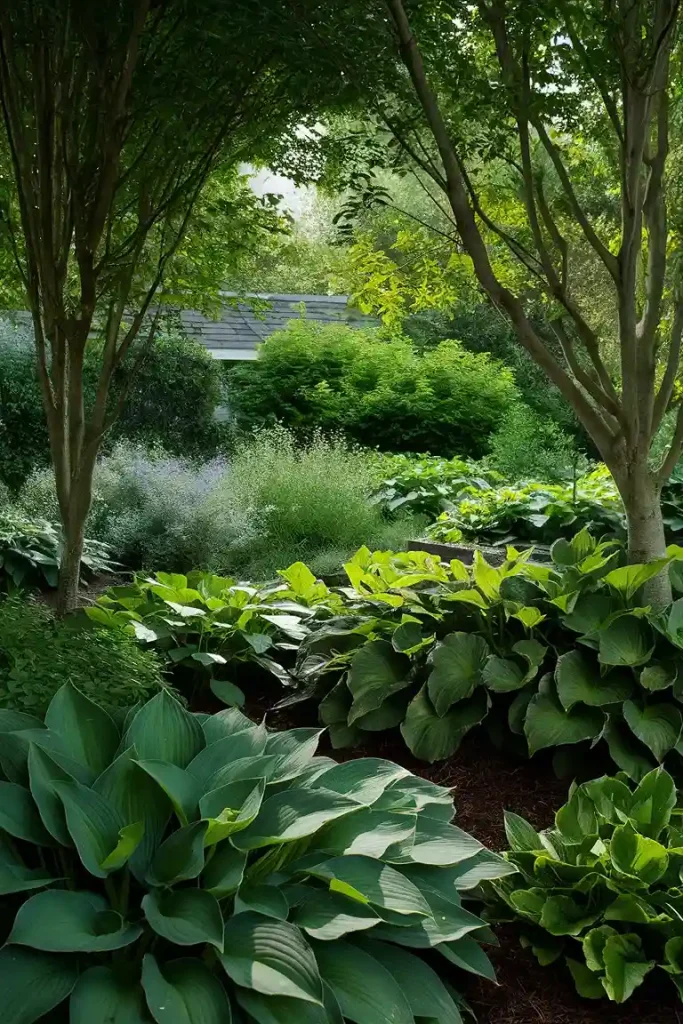
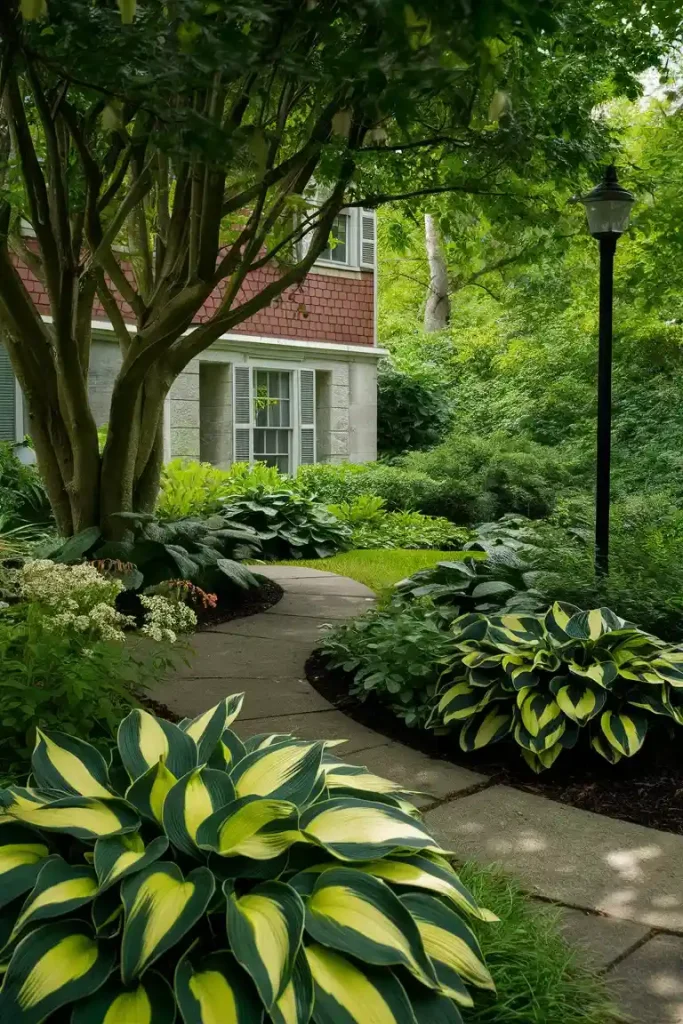
Hostas thrive in the shade, making them perfect for creating a serene garden oasis. This idea involves using hostas to fill in shaded areas under trees or beside buildings, creating a cool, green retreat.
Implementation
- Selection: Choose a mix of hosta varieties with different leaf colors and textures. Varieties like ‘Sum and Substance’ with its large, chartreuse leaves, and ‘Blue Angel’ with its blue-green foliage can create a striking contrast.
- Planting: Space the hostas according to their mature size to avoid overcrowding. Plant them in groups for a more natural look.
- Companions: Add other shade-loving plants like ferns, astilbes, and bleeding hearts to enhance the diversity and interest of your shady garden.
Maintenance
- Watering: Ensure consistent moisture, especially during dry spells.
- Mulching: Apply mulch to retain moisture and suppress weeds.
- Fertilizing: Use a balanced, slow-release fertilizer in the spring.
2. Hosta Border
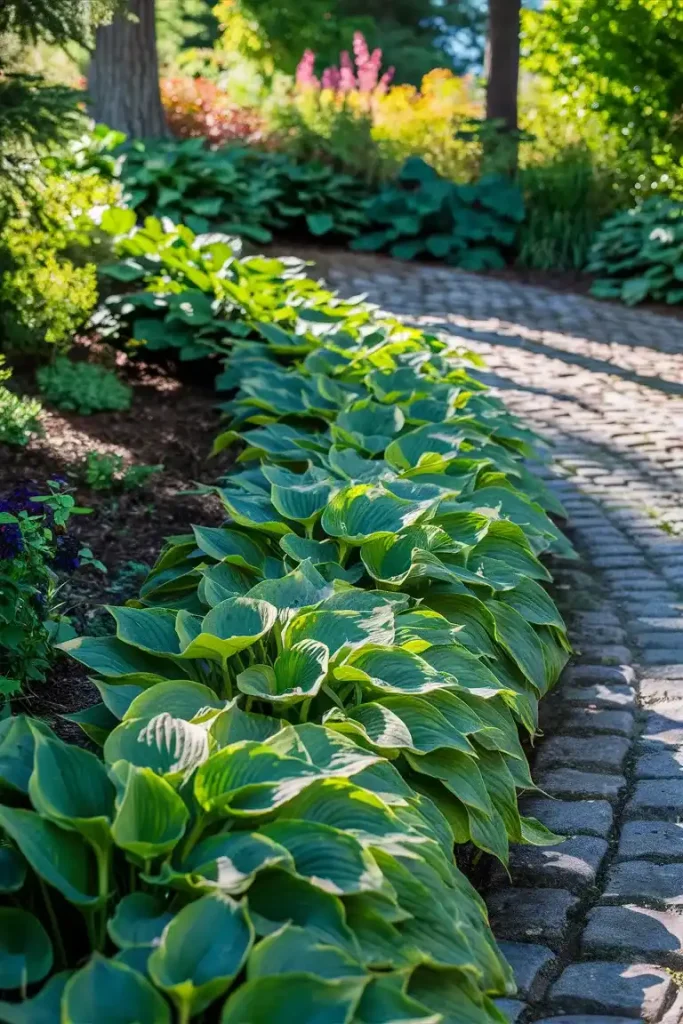
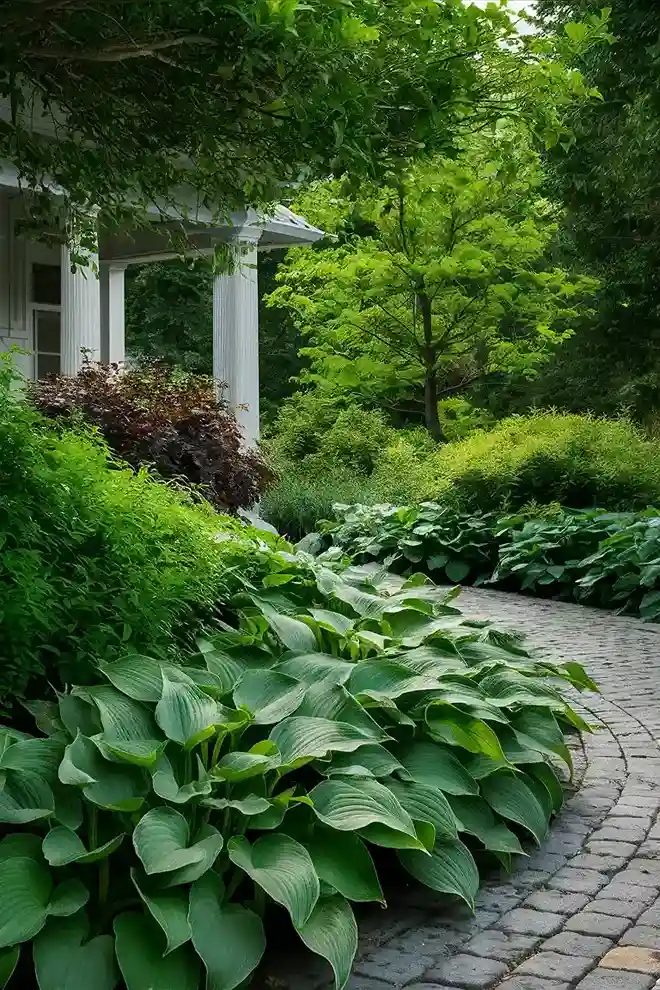
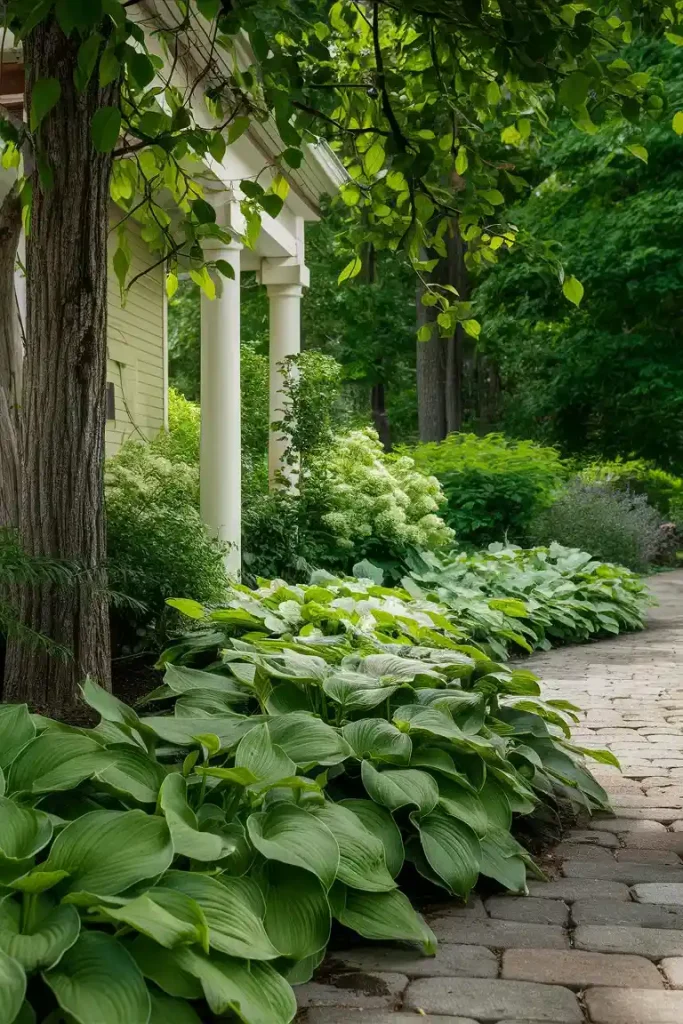
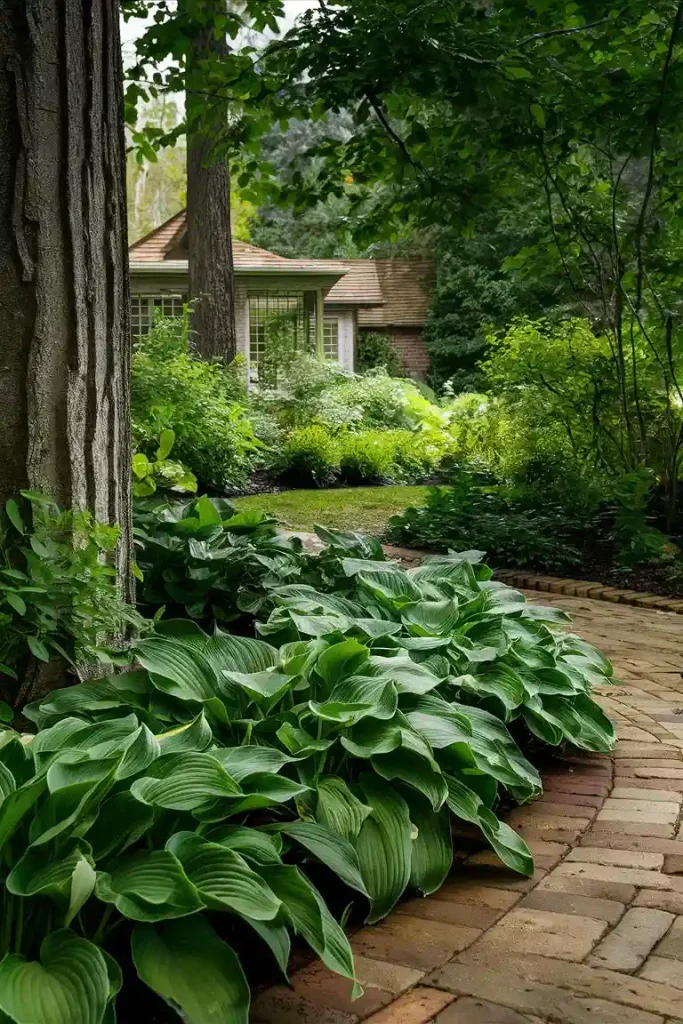
Use hostas to create a lush, green border along pathways, driveways, or garden beds. Their dense foliage will define the edges and provide a beautiful contrast to other plants.
Implementation
- Selection: For a neat, low border, choose smaller varieties like ‘Mouse Ears’ or ‘Golden Tiara’. For a more dramatic effect, opt for larger varieties like ‘Empress Wu’ or ‘Big Daddy’.
- Spacing: Plant hostas closer together for a dense, continuous border.
- Design: Consider alternating colors and textures to create visual interest.
Maintenance
- Trimming: Regularly remove any damaged or yellowing leaves to keep the border looking tidy.
- Dividing: Every few years, divide the hostas to maintain their vigor and prevent overcrowding.
3. Container Gardens
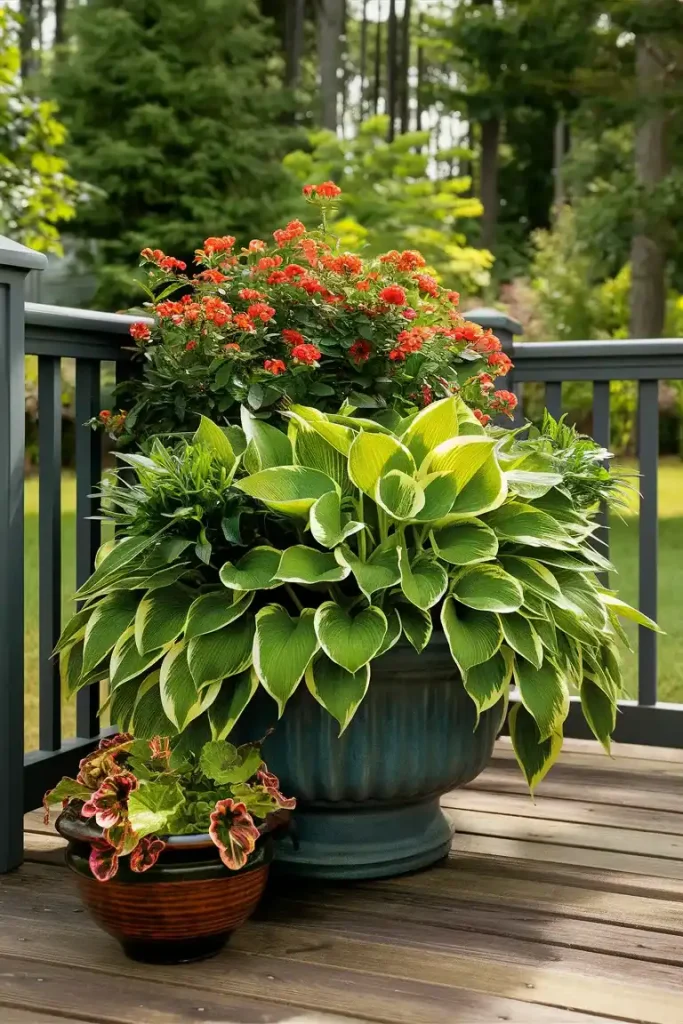
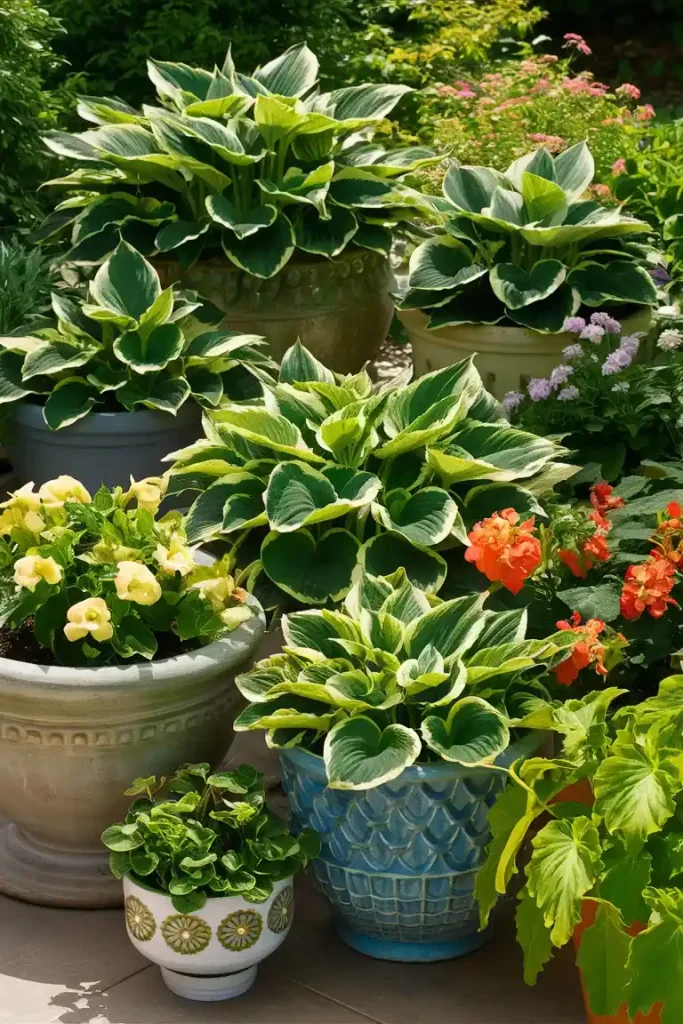
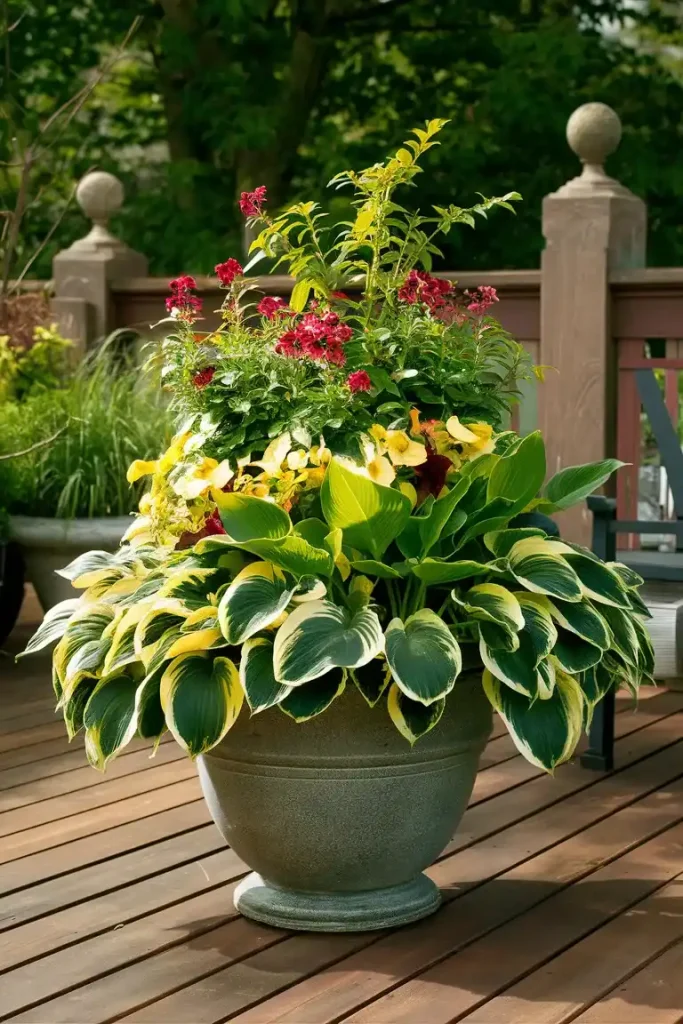
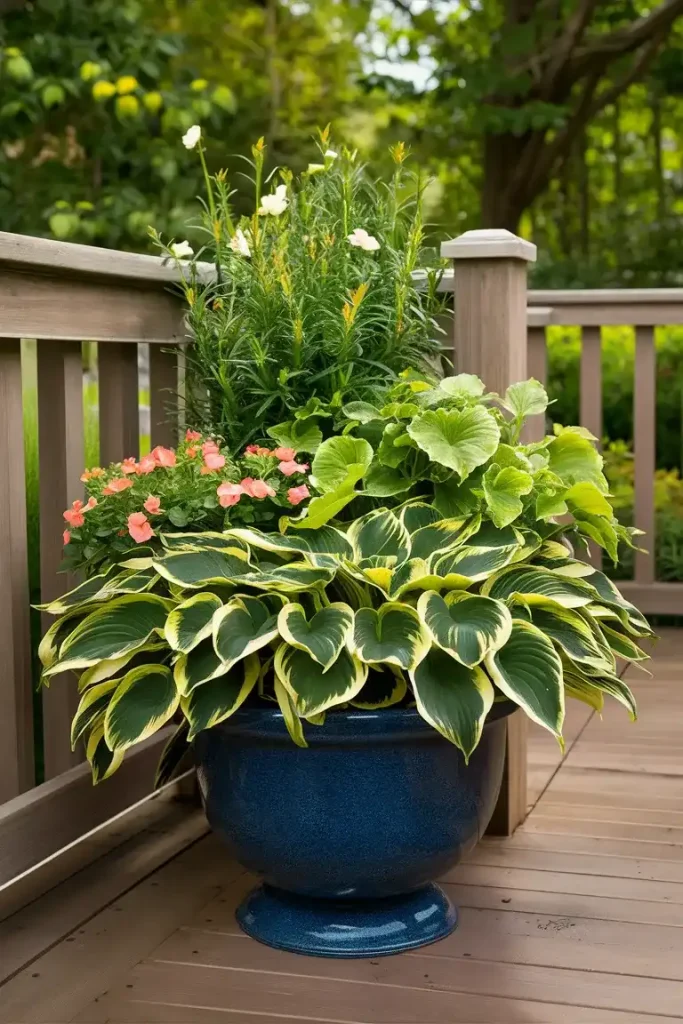
Hostas are excellent candidates for container gardening. Plant them in decorative pots and place them on patios, decks, or balconies.
Implementation
- Containers: Choose pots with good drainage. Consider the size of the hosta when selecting the container.
- Soil: Use a high-quality potting mix with good drainage.
- Arrangement: Combine hostas with other shade-tolerant plants like impatiens or coleus for a mixed container garden.
Maintenance
- Watering: Container plants dry out faster, so water regularly.
- Fertilizing: Use a liquid fertilizer every few weeks during the growing season.
- Winter Care: In colder climates, protect containers from freezing temperatures by moving them to a sheltered location.
4. Mixed Perennial Beds
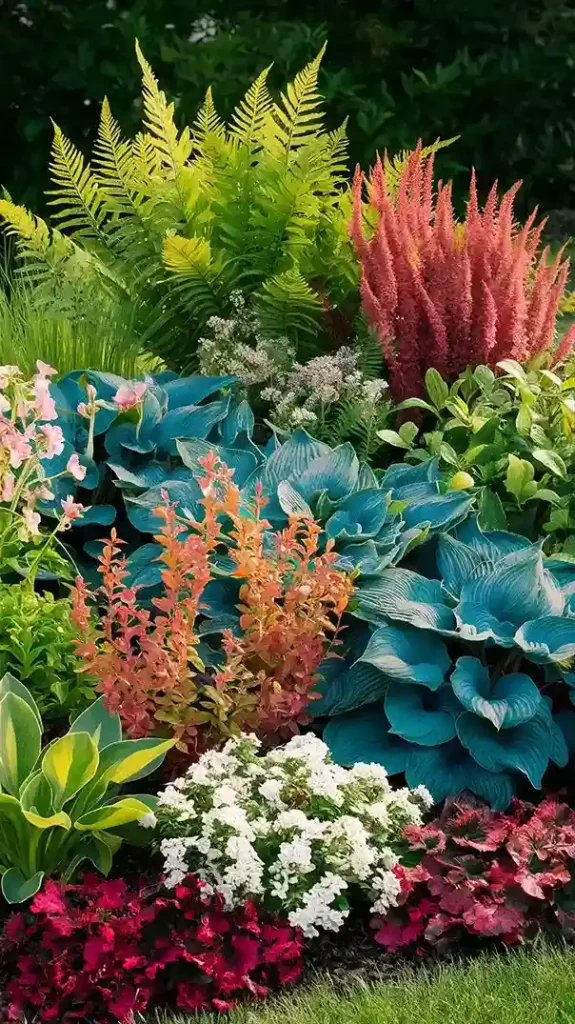
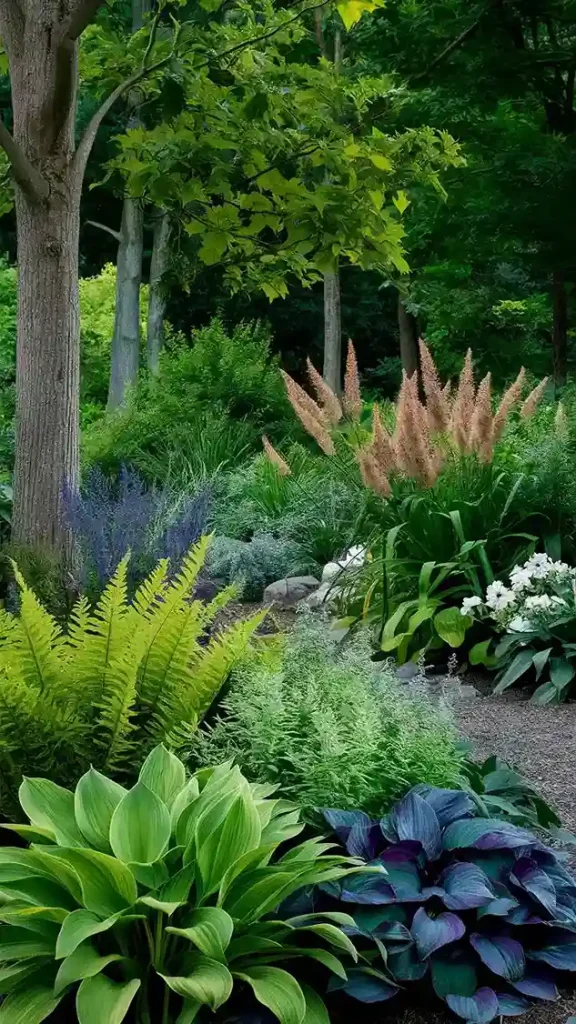
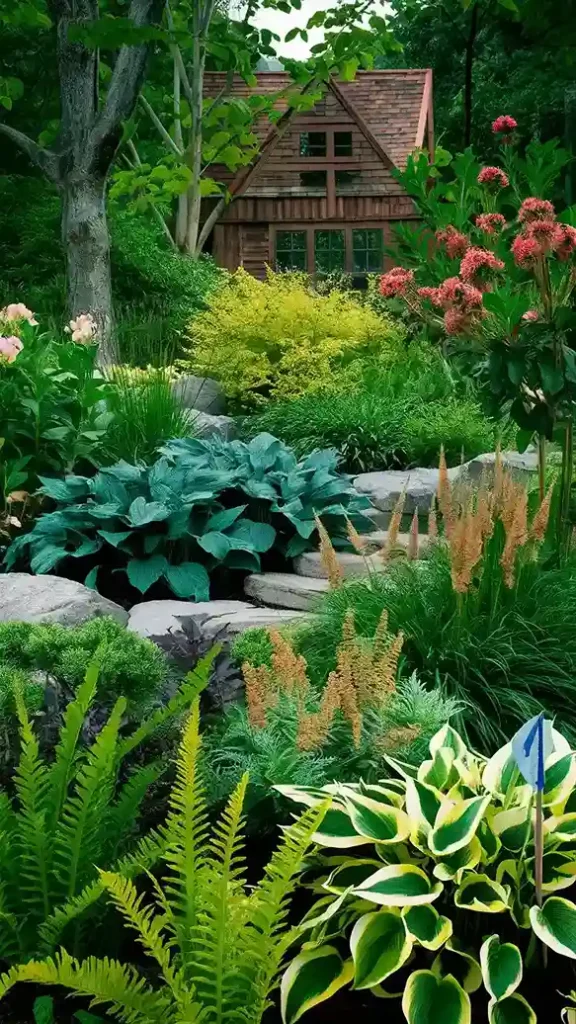
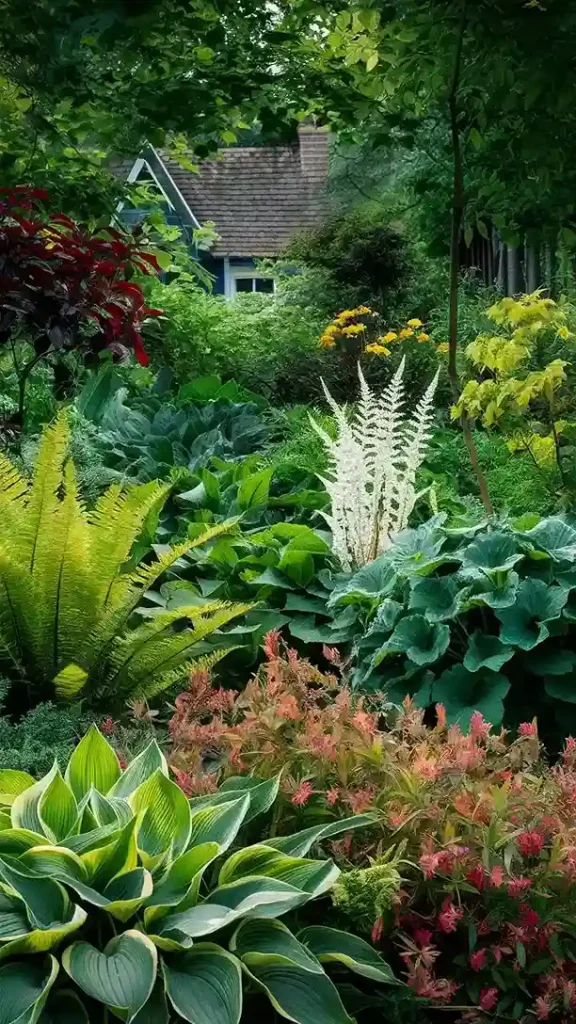
Combine hostas with other shade-loving perennials to create a dynamic and visually appealing garden bed.
Implementation
- Selection: Choose perennials that complement hostas in terms of color, texture, and height. Good companions include ferns, astilbes, heucheras, and brunneras.
- Design: Arrange plants in layers, with taller plants at the back and shorter ones at the front. Use hostas as the foundation plants.
- Color Scheme: Consider a color scheme that harmonizes with the hostas’ foliage. For example, blue hostas pair well with pink or white flowers.
Maintenance
- Weeding: Regularly weed the bed to prevent competition for nutrients.
- Deadheading: Remove spent flowers from companion plants to encourage more blooms.
- Dividing: Divide perennials, including hostas, every few years to maintain their health and vigor.
5. Water Features
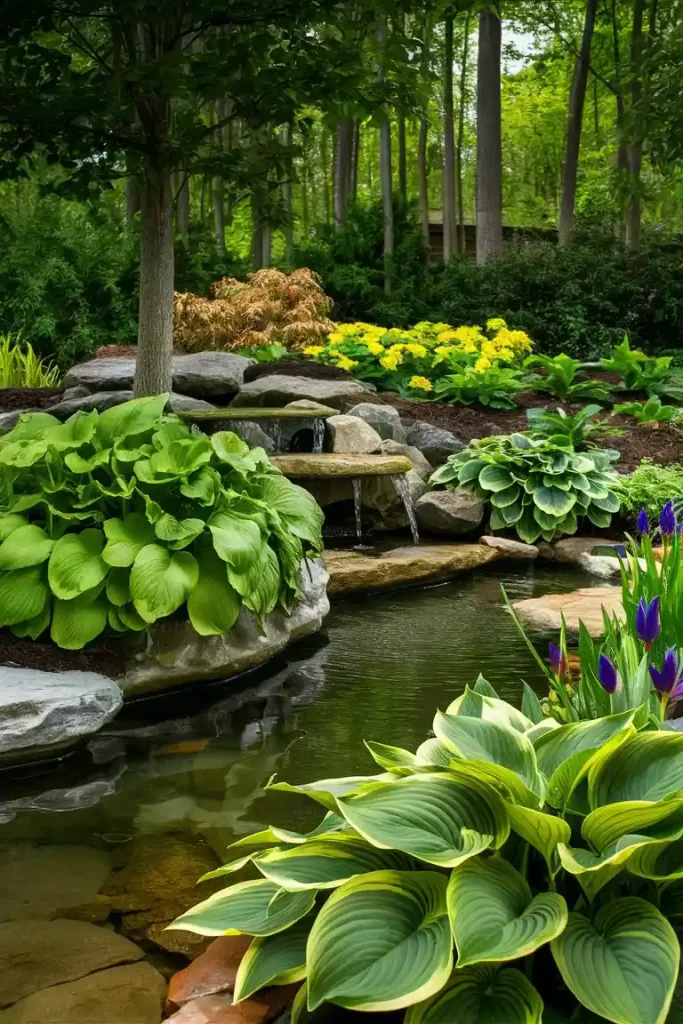
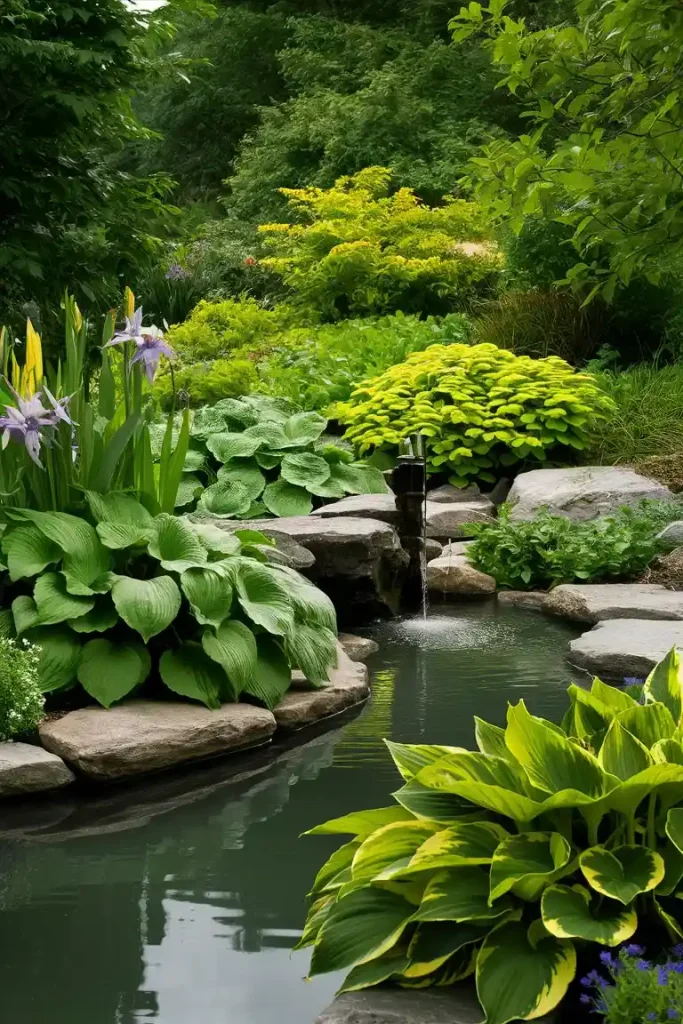
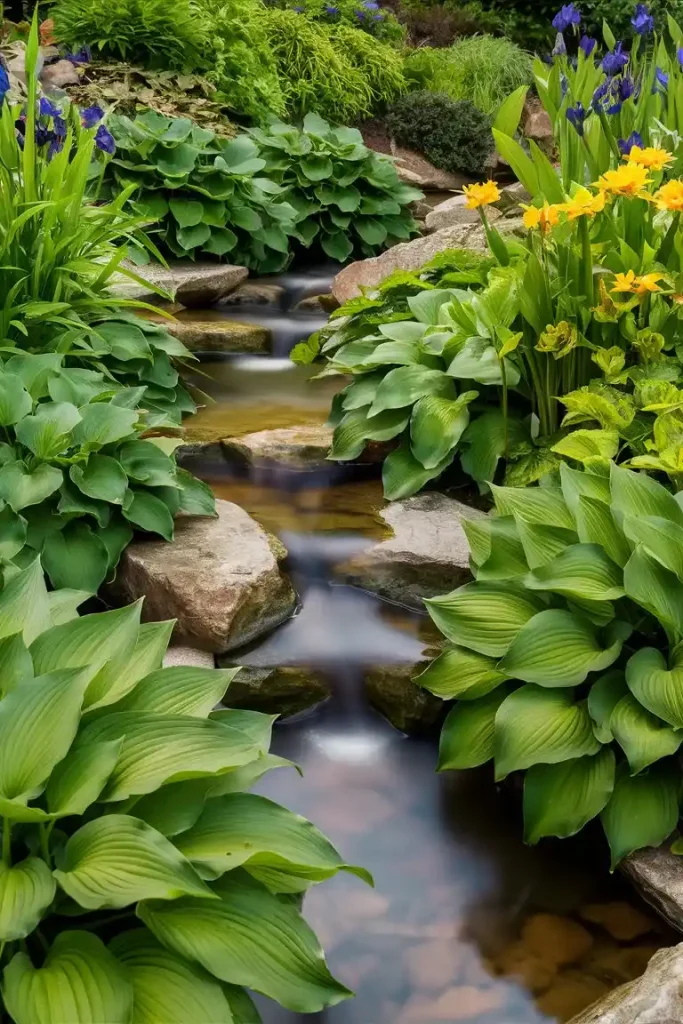
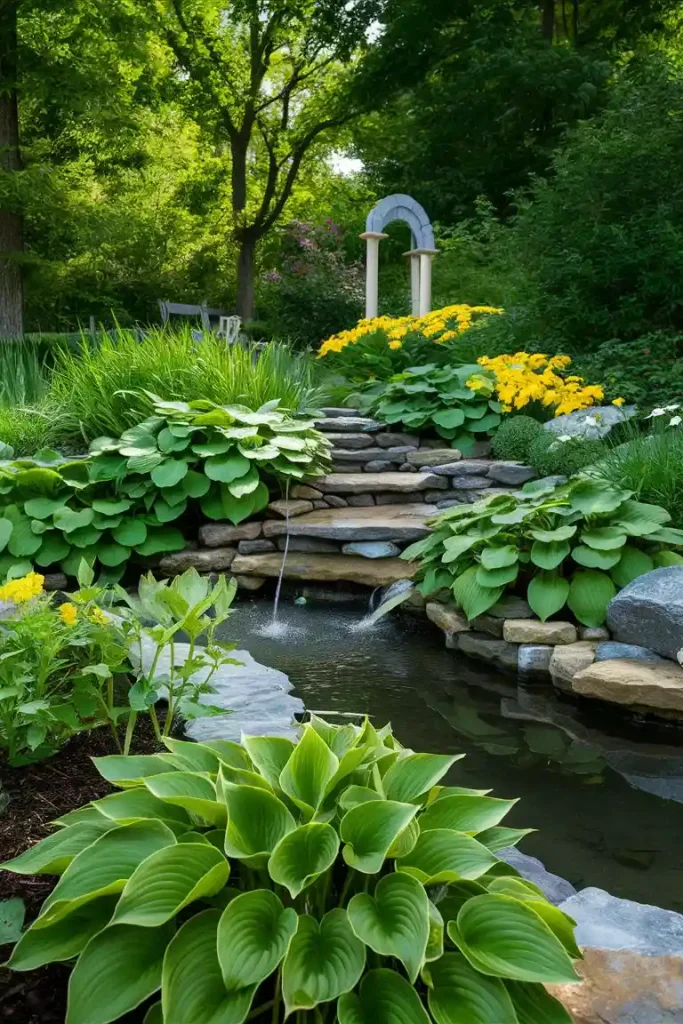
Hostas’ lush foliage looks stunning next to water features like ponds, fountains, or streams. Their reflective leaves can enhance the tranquil atmosphere of a water garden.
Implementation
- Placement: Plant hostas along the edges of water features to soften the hard lines of rocks and water structures.
- Varieties: Choose varieties with large, reflective leaves like ‘Frances Williams’ or ‘Patriot’ to maximize the visual impact.
- Companions: Add moisture-loving plants like iris, marsh marigold, and water lilies to complement the hostas.
Maintenance
- Watering: Ensure the soil remains consistently moist, especially during dry periods.
- Mulching: Apply mulch to retain moisture and reduce weed growth.
- Pest Control: Watch for slugs and snails, which are attracted to the moist environment.
6. Rock Gardens
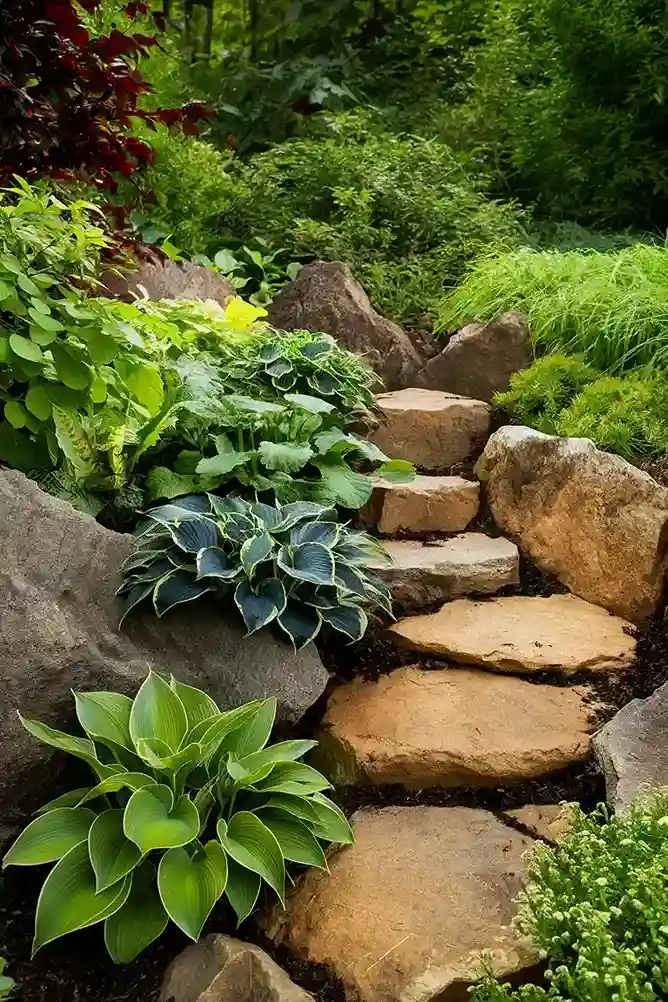
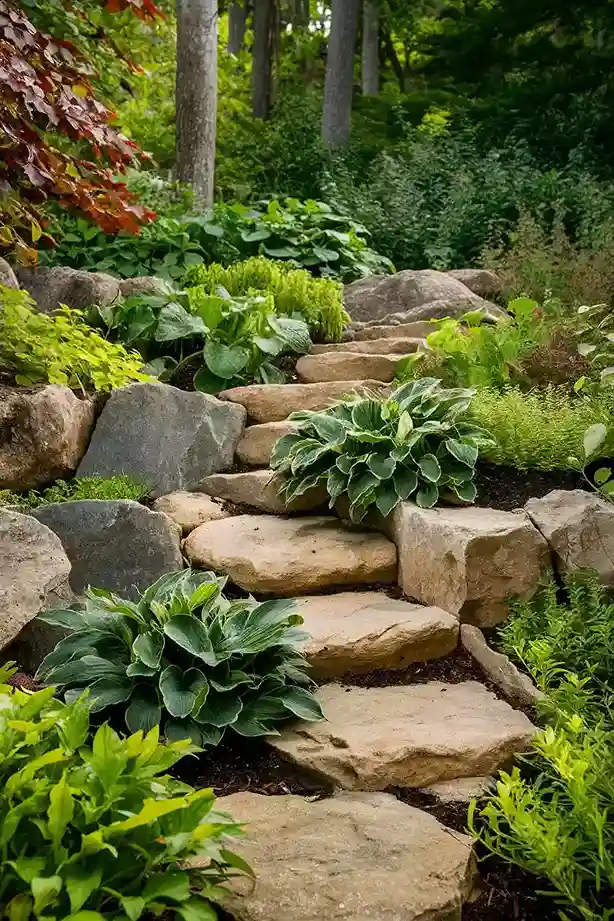
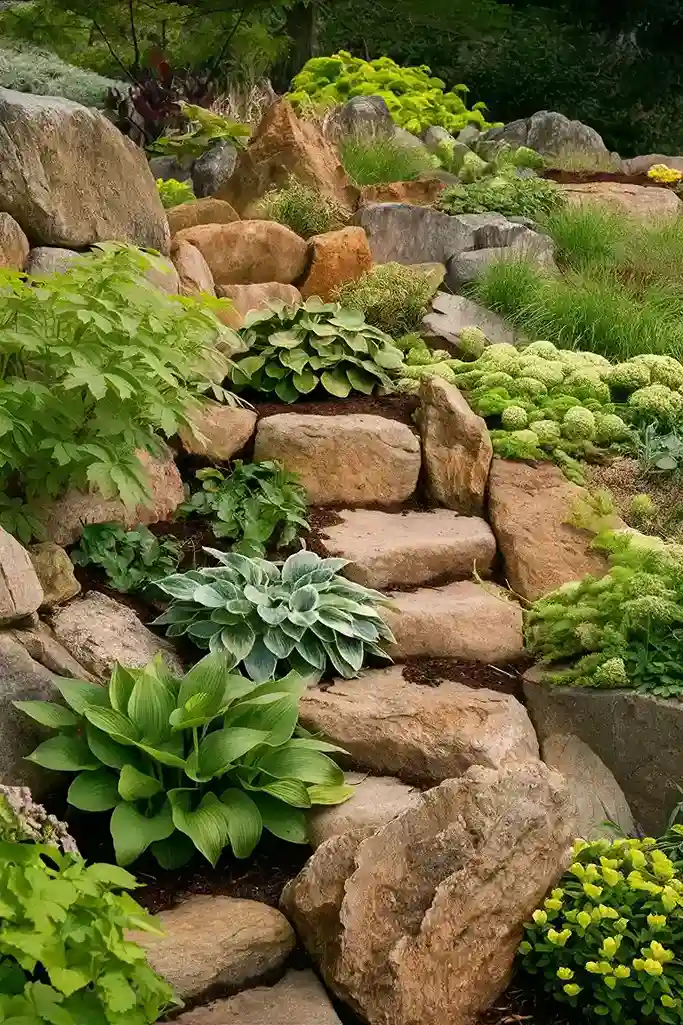
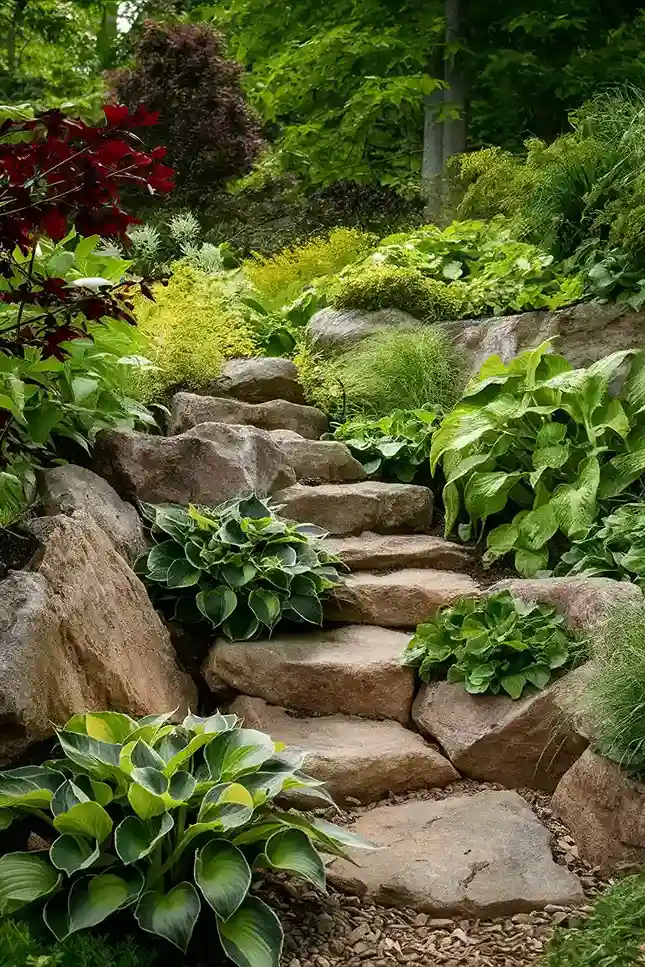
Incorporate hostas into rock gardens for a striking contrast between the soft, leafy plants and the rugged stones.
Implementation
- Selection: Choose smaller hosta varieties like ‘Blue Mouse Ears’ or ‘Pandora’s Box’ that can nestle into crevices.
- Placement: Plant hostas in pockets of soil between rocks. Ensure good drainage to prevent root rot.
- Design: Use a mix of rock sizes and shapes to create a natural look. Add other rock garden plants like sedums and saxifrages.
Maintenance
- Watering: Water regularly, but ensure good drainage to prevent waterlogging.
- Weeding: Keep the area free of weeds to reduce competition for nutrients.
- Dividing: Divide hostas every few years to maintain their size and health.
7. Hosta Walkway
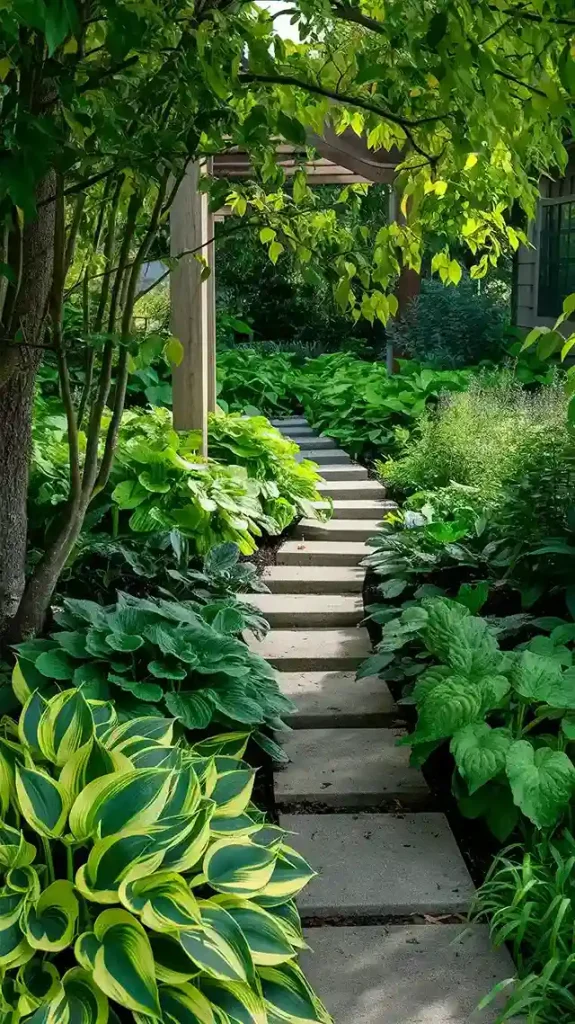
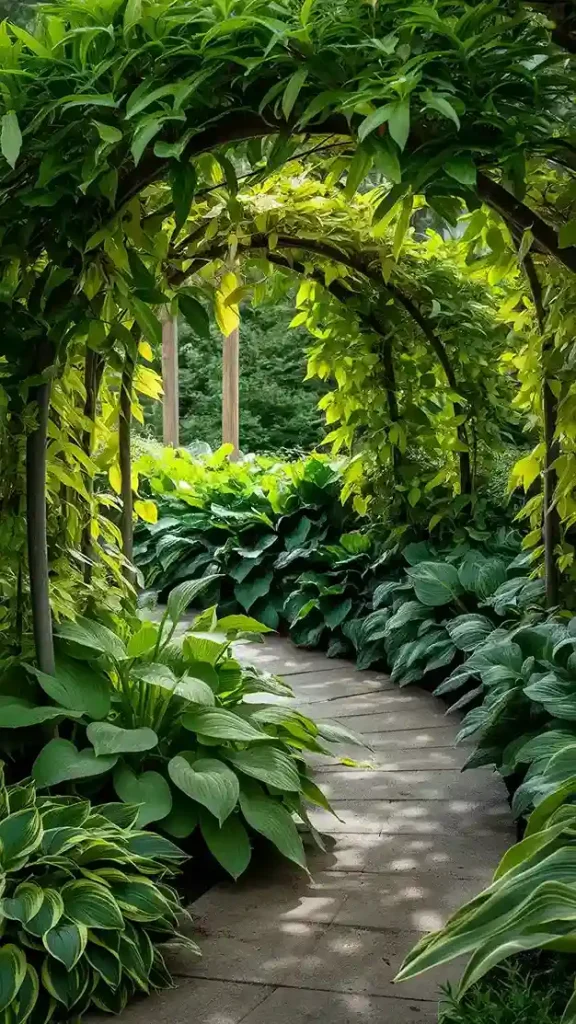
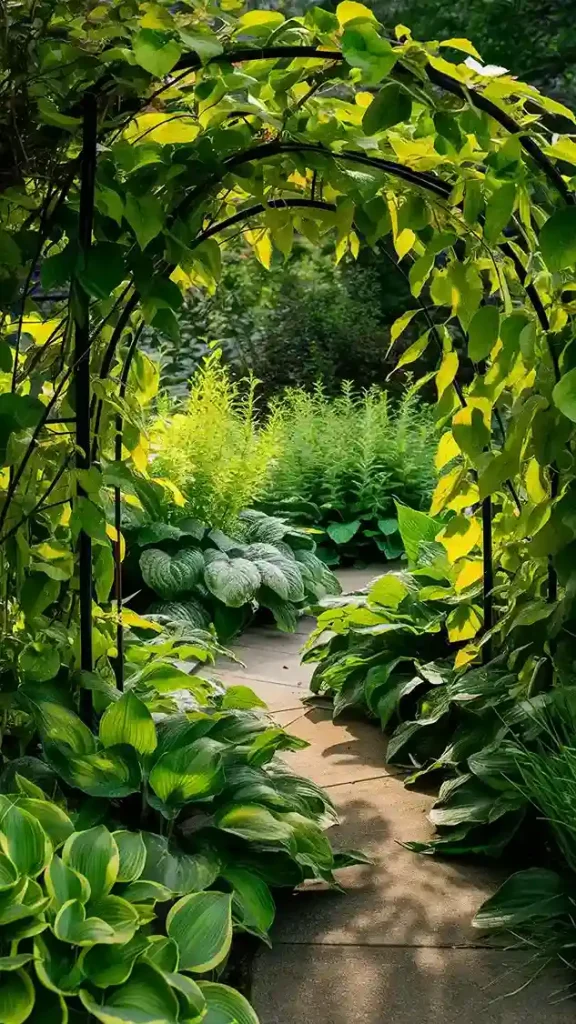
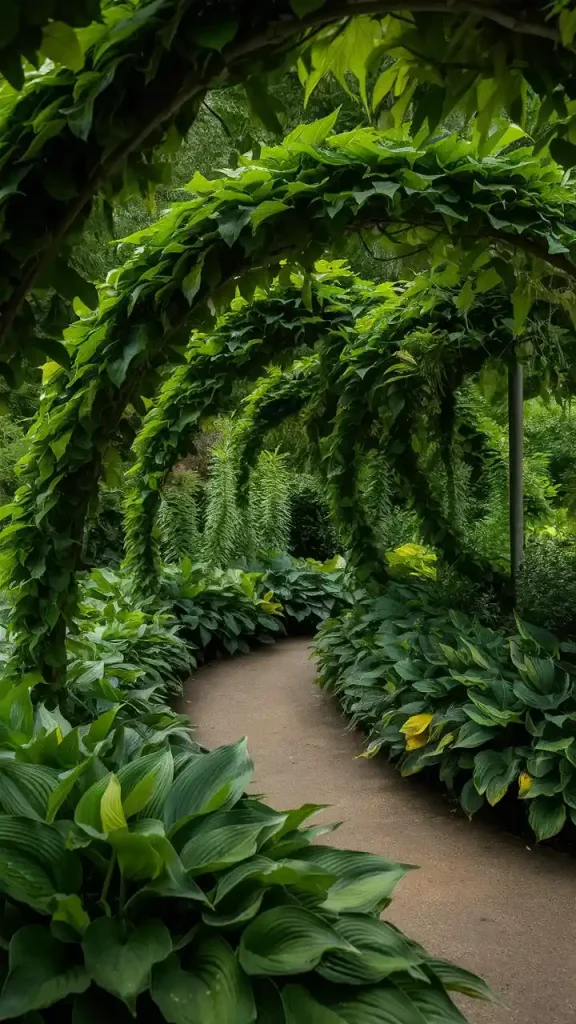
Line a garden path with hostas to create a lush, inviting walkway. The arching leaves will gently brush against you as you walk, creating a sense of immersion in nature.
Implementation
- Selection: Choose a mix of hosta varieties with different heights and colors. Taller varieties like ‘Sagae’ can be placed at the back, with shorter ones like ‘June’ at the front.
- Spacing: Plant hostas close enough to create a continuous border but with enough space to allow for growth.
- Design: Consider a curved path to add a sense of mystery and discovery.
Maintenance
- Trimming: Regularly remove any damaged or yellowing leaves to keep the walkway looking tidy.
- Mulching: Apply mulch to retain moisture and suppress weeds.
- Dividing: Divide hostas every few years to maintain their vigor and prevent overcrowding.
8. Foundation Plantings
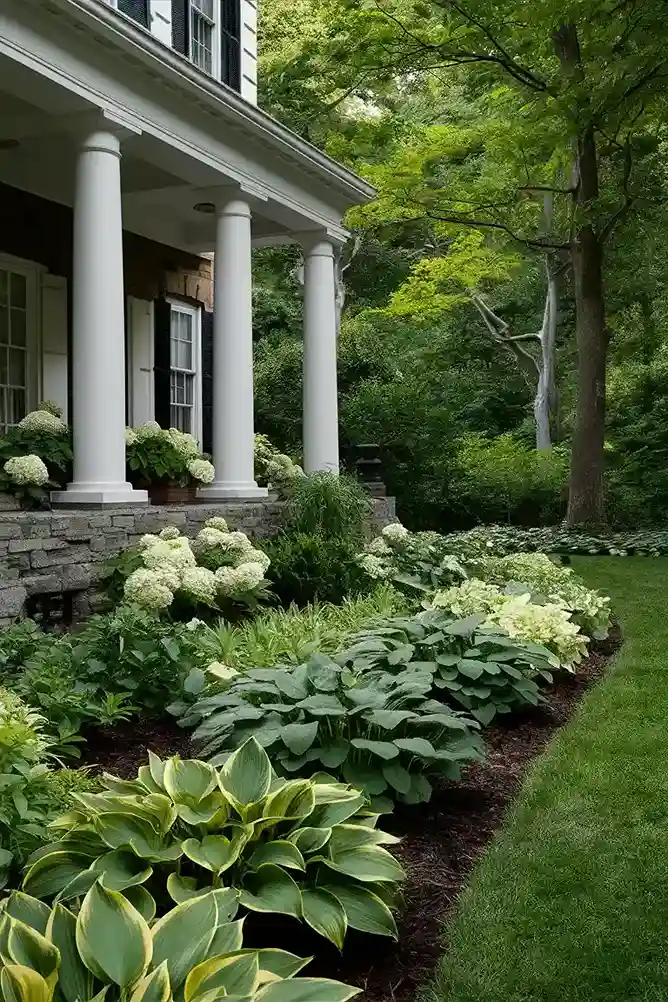
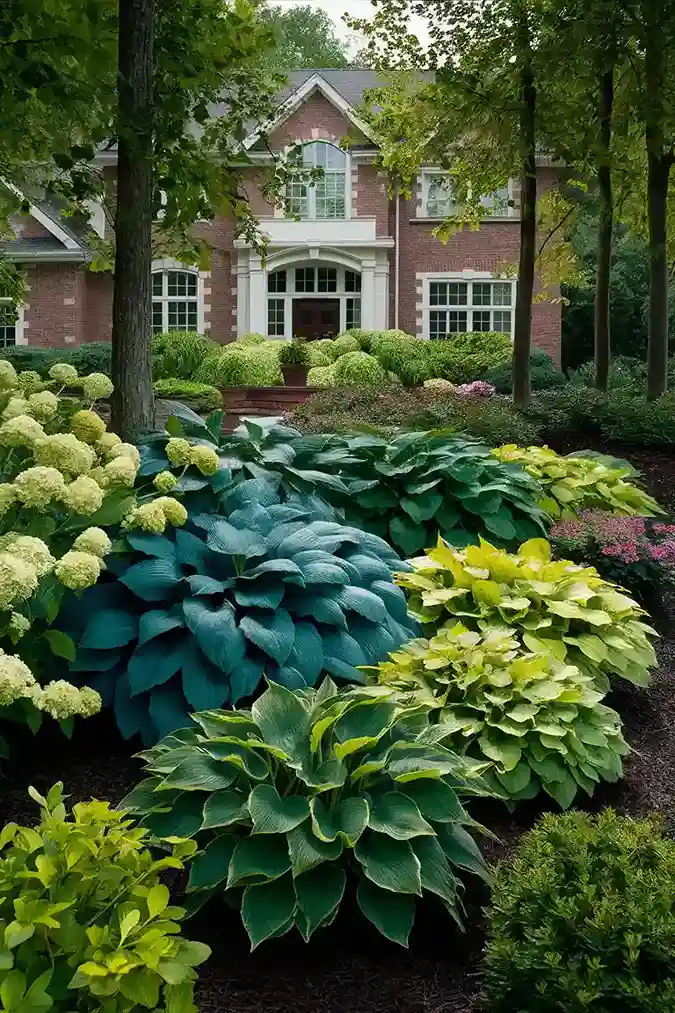
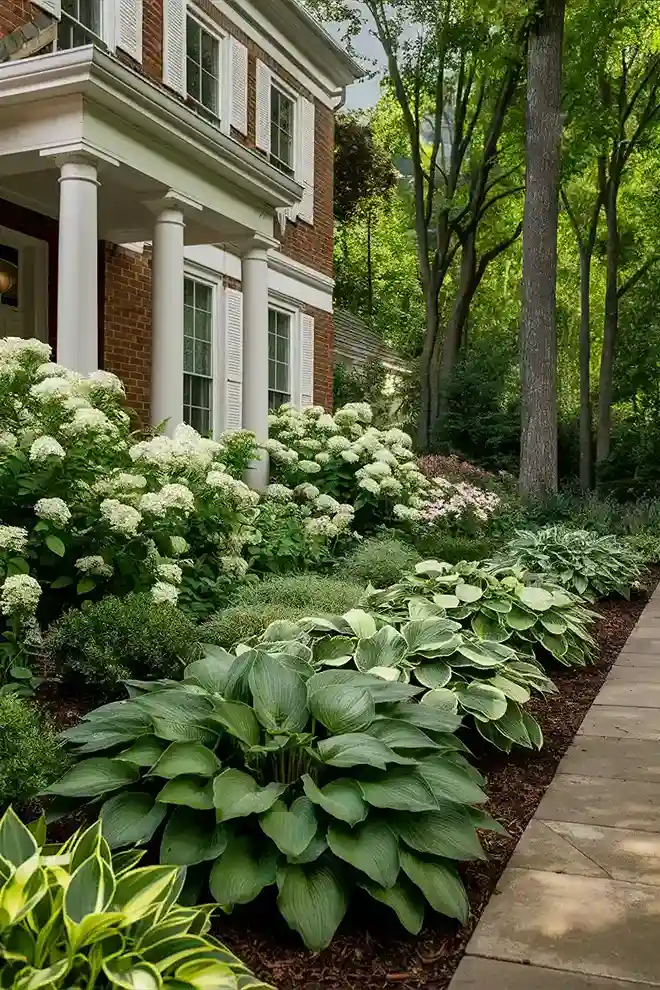
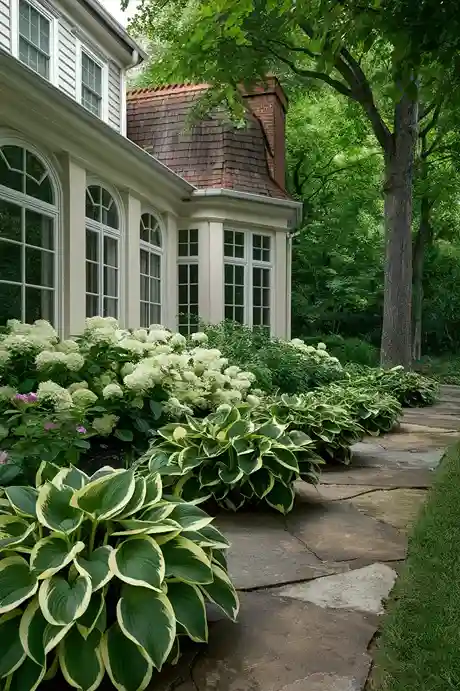
Plant hostas around the foundation of your home to soften the transition between the building and the landscape.
Implementation
- Selection: Choose larger varieties like ‘Sum and Substance’ or ‘Blue Angel’ for a dramatic effect, or smaller varieties like ‘Golden Tiara’ for a more subtle look.
- Placement: Plant hostas in groups along the foundation, spacing them according to their mature size.
- Design: Mix hostas with other foundation plants like hydrangeas, azaleas, and boxwoods for a layered look.
Maintenance
- Watering: Ensure consistent moisture, especially during dry spells.
- Mulching: Apply mulch to retain moisture and suppress weeds.
- Fertilizing: Use a balanced, slow-release fertilizer in the spring.
9. Hosta Island
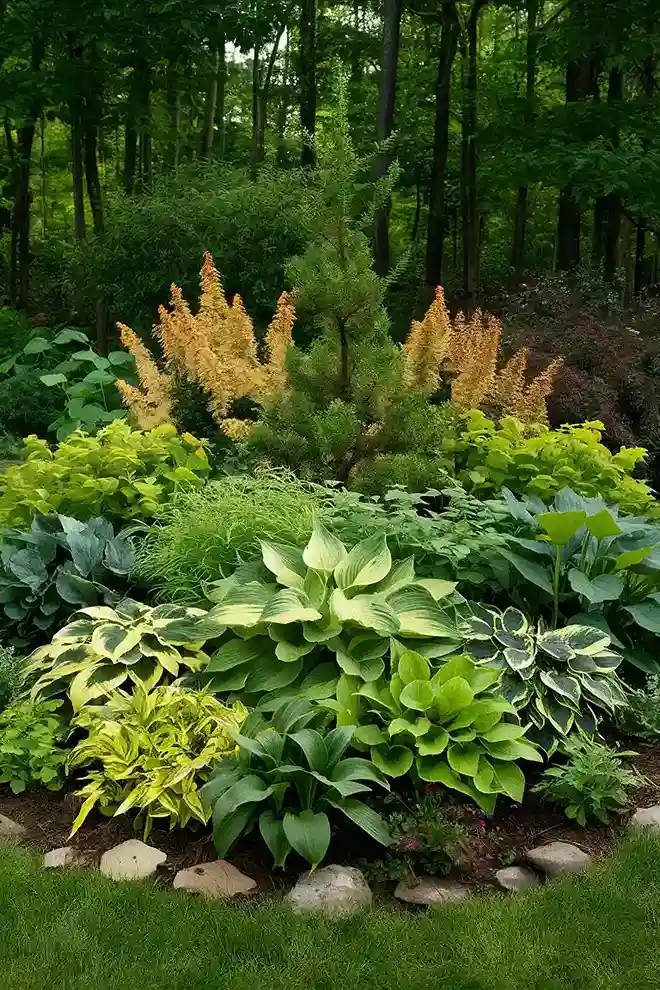
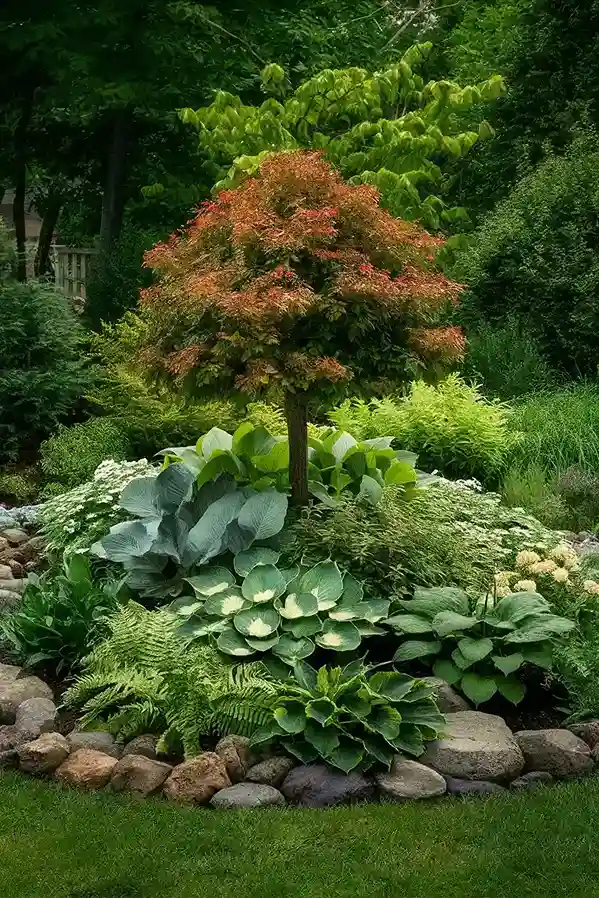
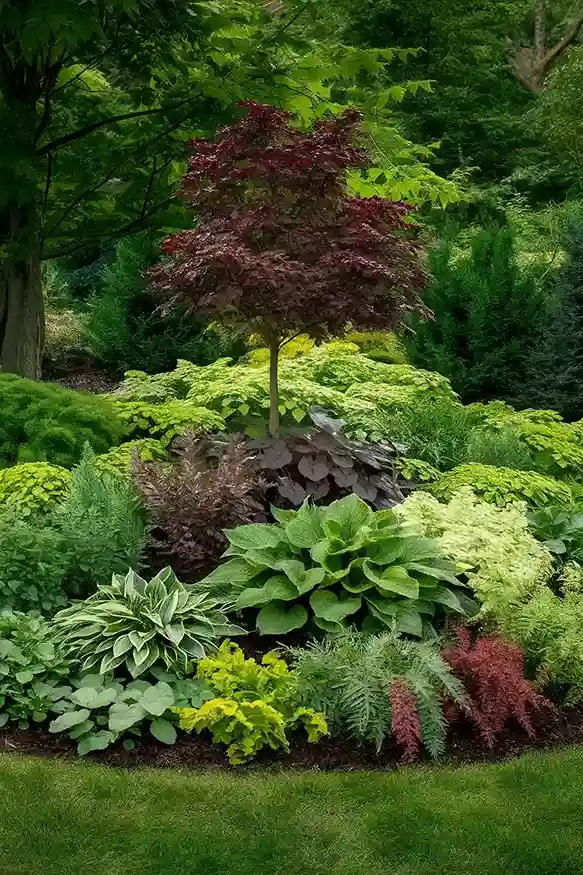
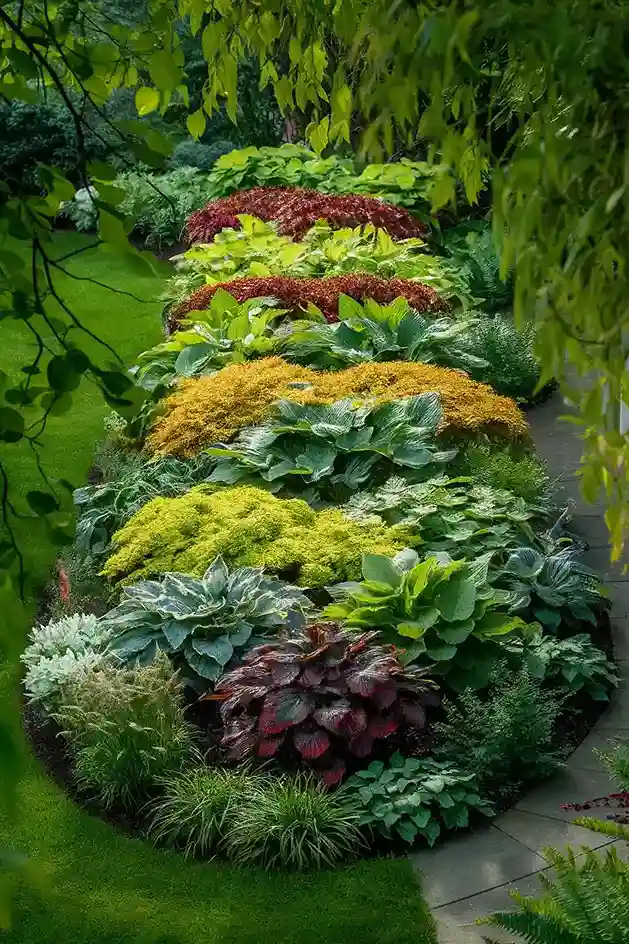
Create a focal point in your garden by planting a “hosta island.” This standalone feature will draw the eye and add a unique element to your landscape.
Implementation
- Selection: Choose a variety of hostas with different colors, sizes, and textures. Varieties like ‘Guacamole’, ‘Fire and Ice’, and ‘Halcyon’ can create a stunning display.
- Design: Plant hostas in a circular or irregular shape in the middle of a lawn or garden bed. Use taller varieties in the center and shorter ones around the edges.
- Companions: Add other shade-loving plants like ferns, heucheras, and astilbes to enhance the diversity and interest of your hosta island.
Maintenance
- Watering: Ensure consistent moisture, especially during dry spells.
- Mulching: Apply mulch to retain moisture and suppress weeds.
- Dividing: Divide hostas every few years to maintain their vigor and prevent overcrowding.
10. Understory Planting
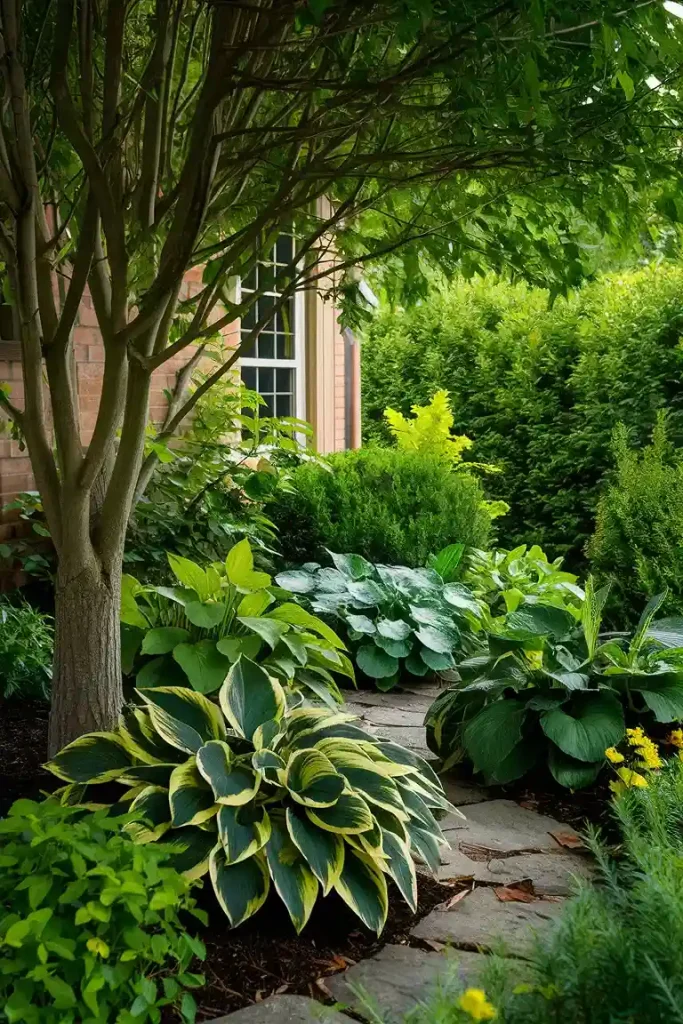
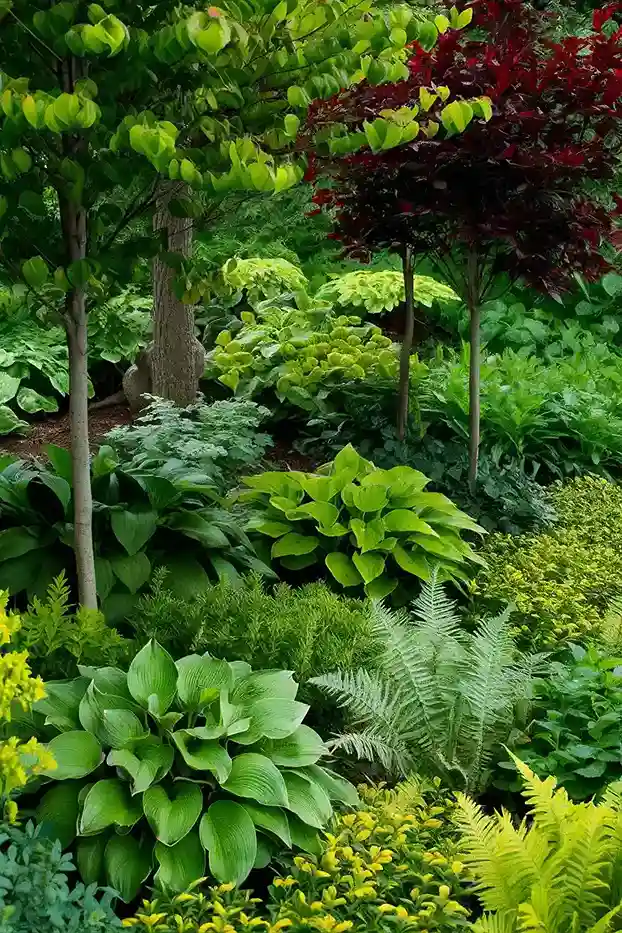
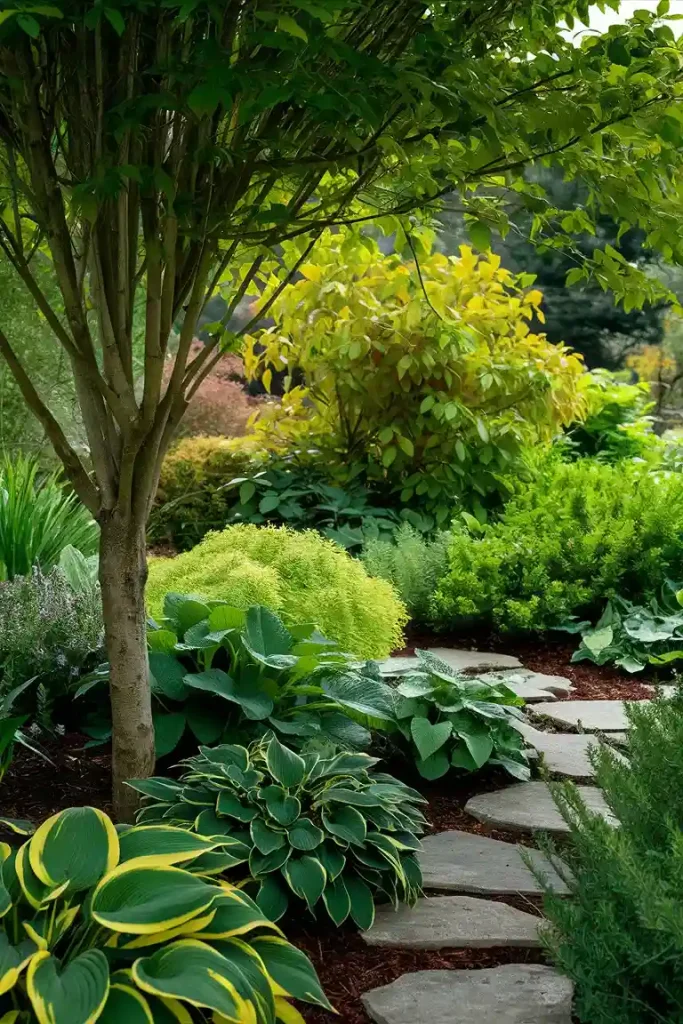
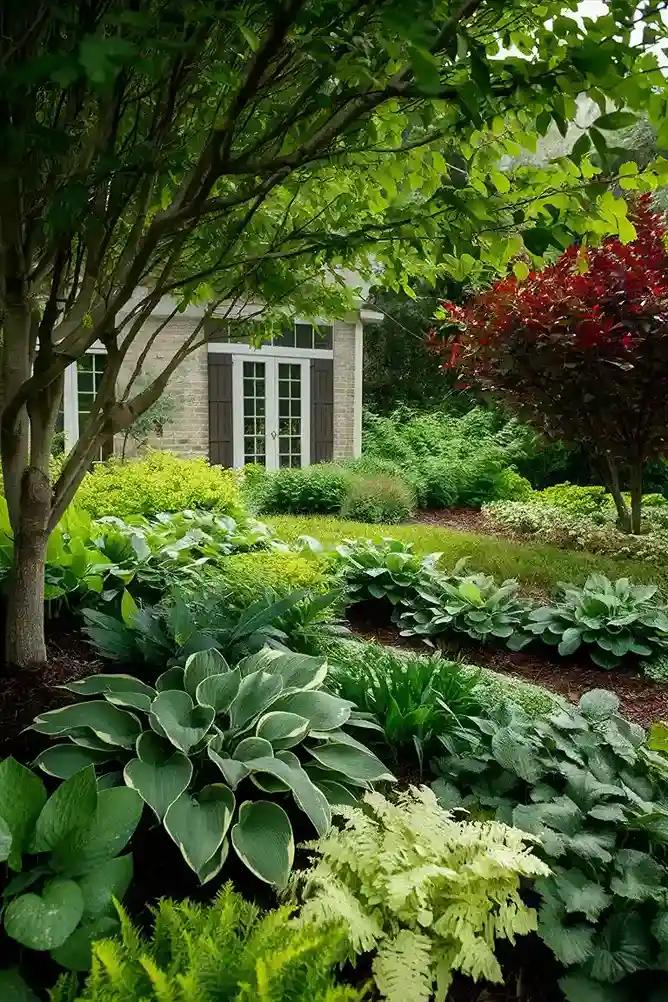
Hostas are perfect for planting under taller shrubs and trees. Their shade tolerance makes them ideal companions for larger plants.
Implementation
- Selection: Choose hosta varieties that will thrive in the dappled shade of taller plants. Varieties like ‘Frances Williams’ and ‘Patriot’ are good choices.
- Placement: Plant hostas in groups under the canopy of trees or shrubs, spacing them according to their mature size.
- Design: Mix hostas with other understory plants like ferns, hellebores, and epimediums for a layered look.
Maintenance
- Watering: Ensure consistent moisture, especially during dry spells.
- Mulching: Apply mulch to retain moisture and suppress weeds.
- Fertilizing: Use a balanced, slow-release fertilizer in the spring.
11. Hosta Hedge
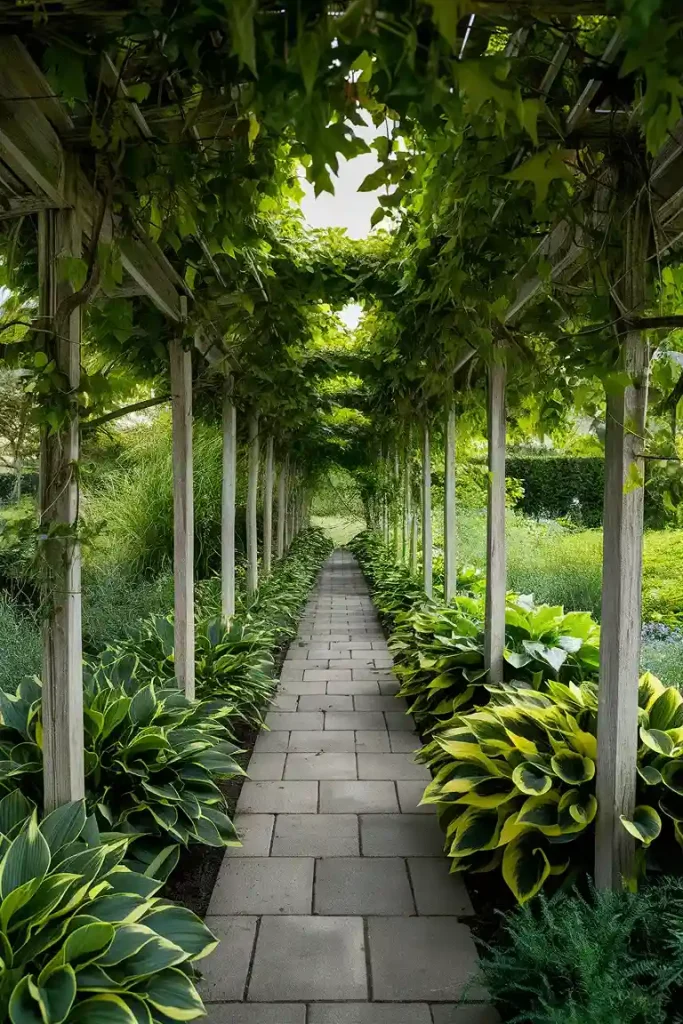
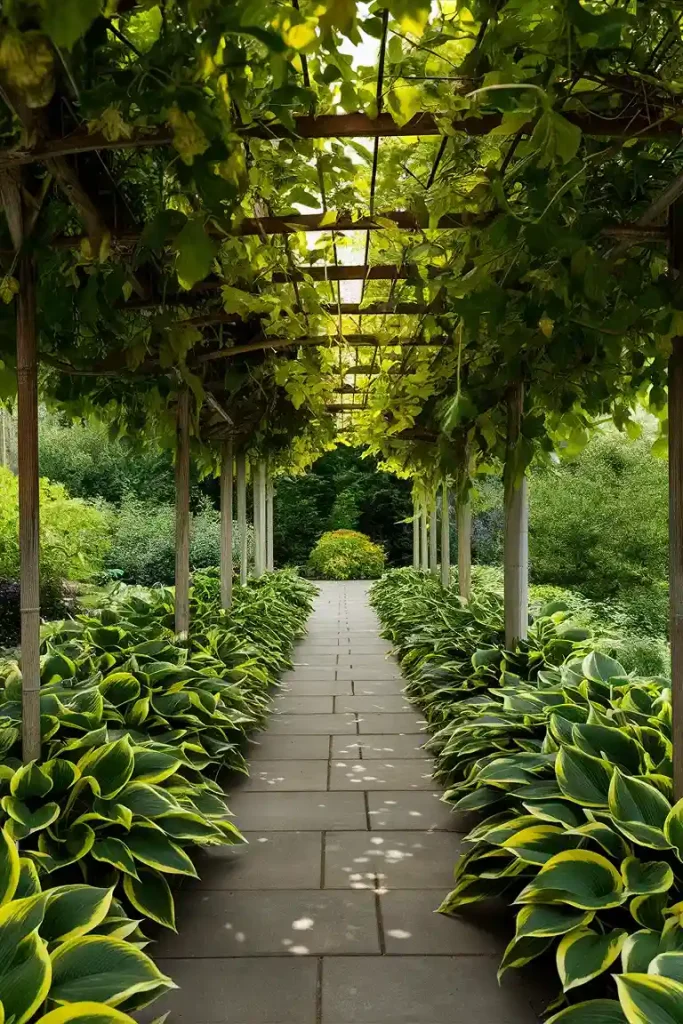
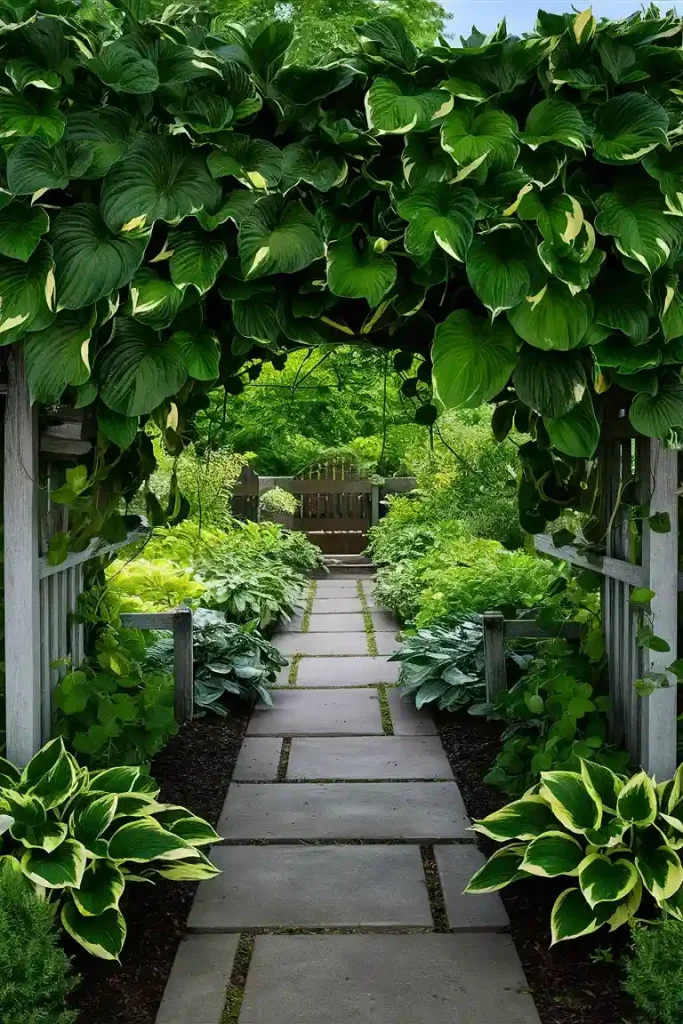
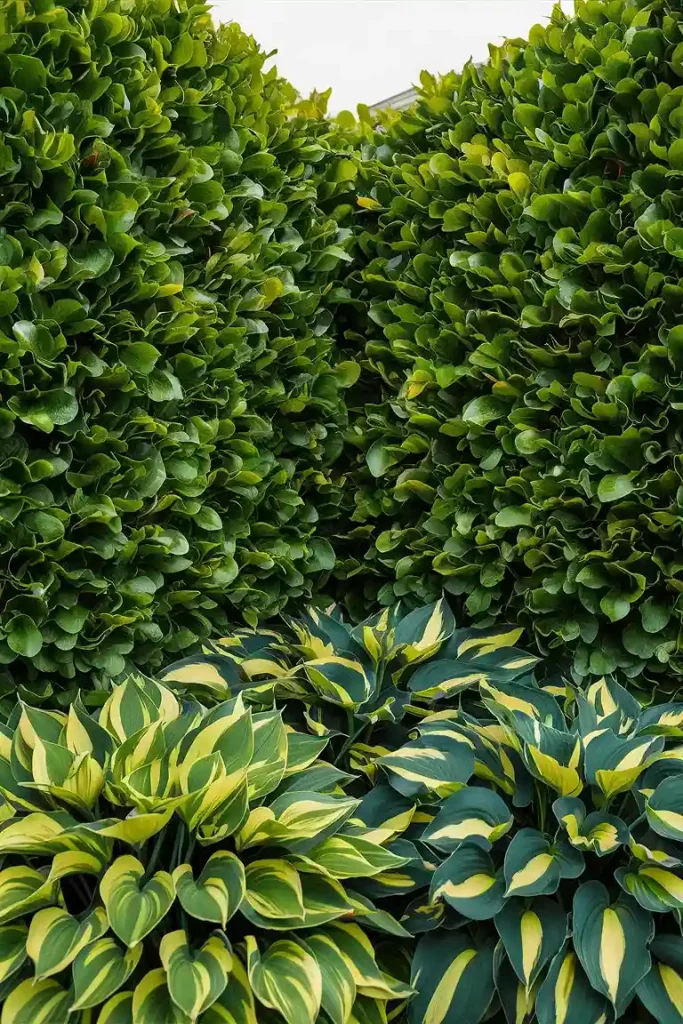
For a unique twist on a traditional hedge, plant a row of large hostas. Their dense foliage will create a lush, green barrier that can provide privacy and define garden spaces.
Implementation
- Selection: Choose large hosta varieties like ‘Empress Wu’ or ‘Sum and Substance’ for a dramatic effect.
- Spacing: Plant hostas close together to create a continuous hedge.
- Design: Consider alternating colors and textures to create visual interest.
Maintenance
- Trimming: Regularly remove any damaged or yellowing leaves to keep the hedge looking tidy.
- Mulching: Apply mulch to retain moisture and suppress weeds.
- Dividing: Divide hostas every few years to maintain their vigor and prevent overcrowding.
12. Seasonal Interest
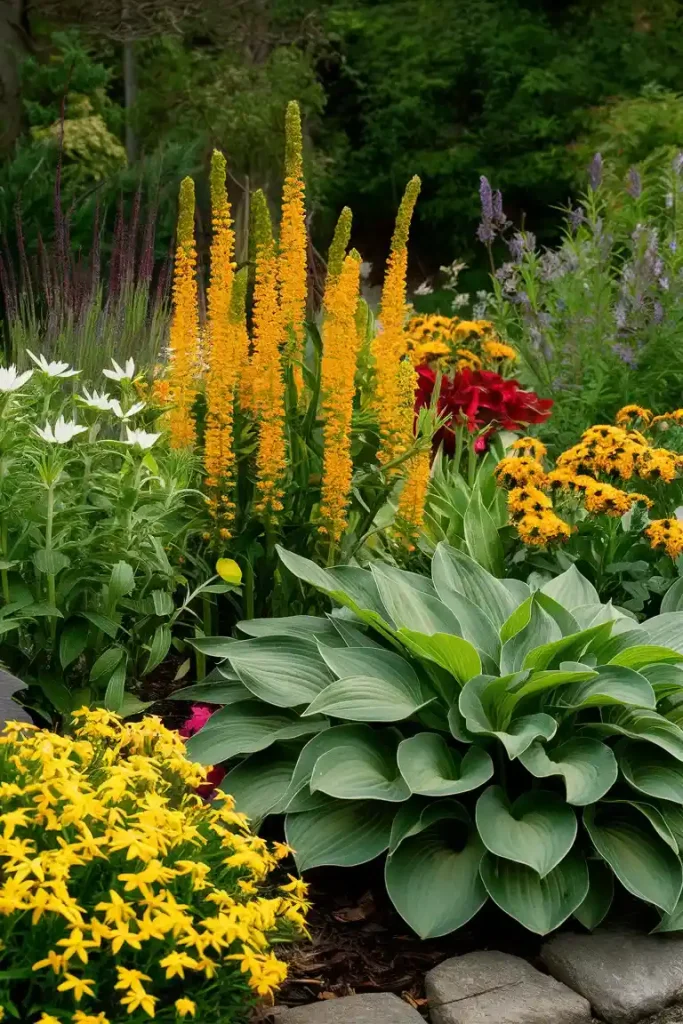
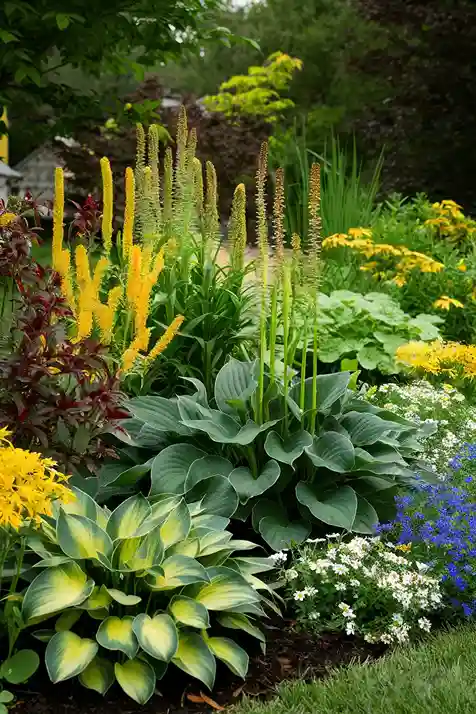
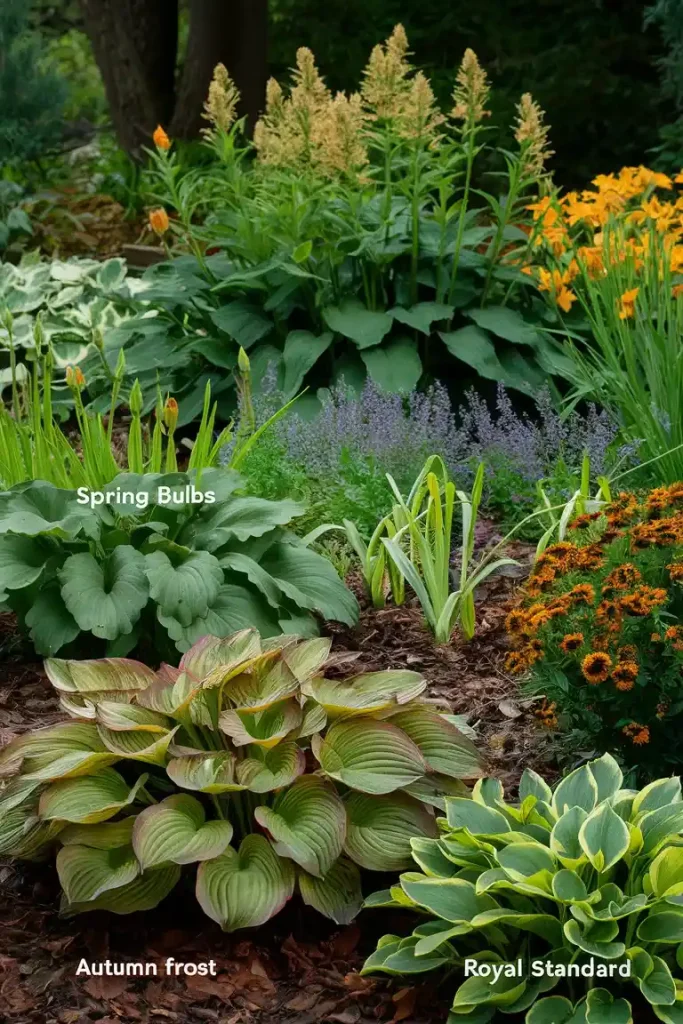
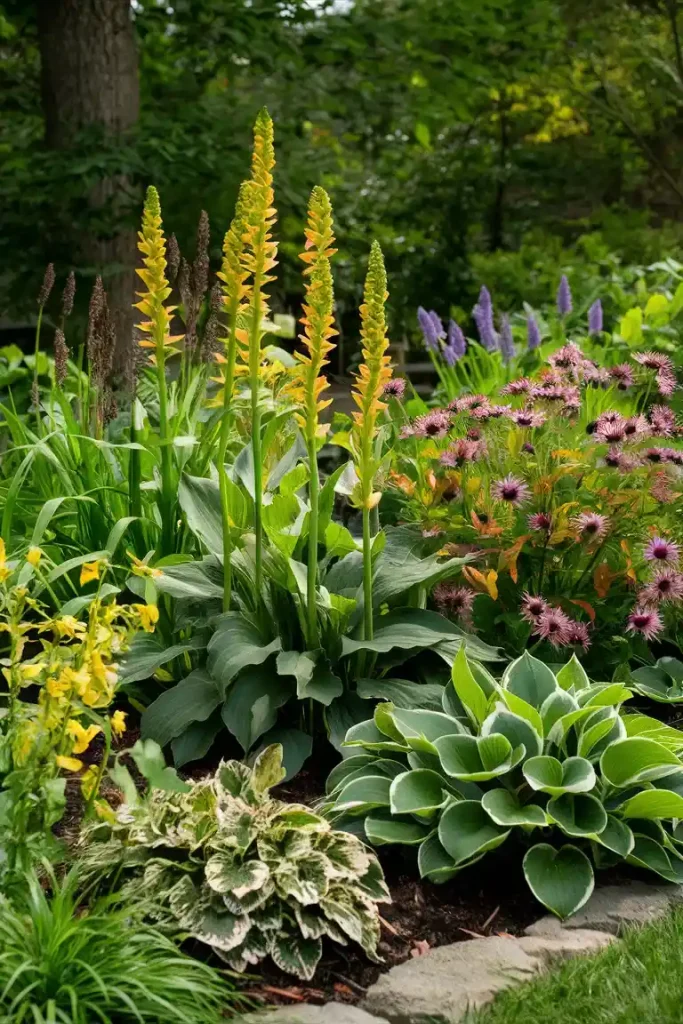
Hostas offer more than just summer beauty. Many varieties have interesting fall colors, and their flower spikes can add vertical interest.
Implementation
- Selection: Choose hosta varieties with different seasonal features. Varieties like ‘Autumn Frost’ have striking fall colors, while ‘Royal Standard’ produces fragrant flowers.
- Companions: Combine hostas with other plants that have different seasonal features, like spring bulbs, summer perennials, and fall-blooming asters.
- Design: Arrange plants to ensure continuous interest throughout the seasons.
Maintenance
- Weeding: Regularly weed the bed to prevent competition for nutrients.
- Deadheading: Remove spent flowers from hostas and companion plants to encourage more blooms.
- Dividing: Divide hostas every few years to maintain their health and vigor.
13. Hosta Collection Garden
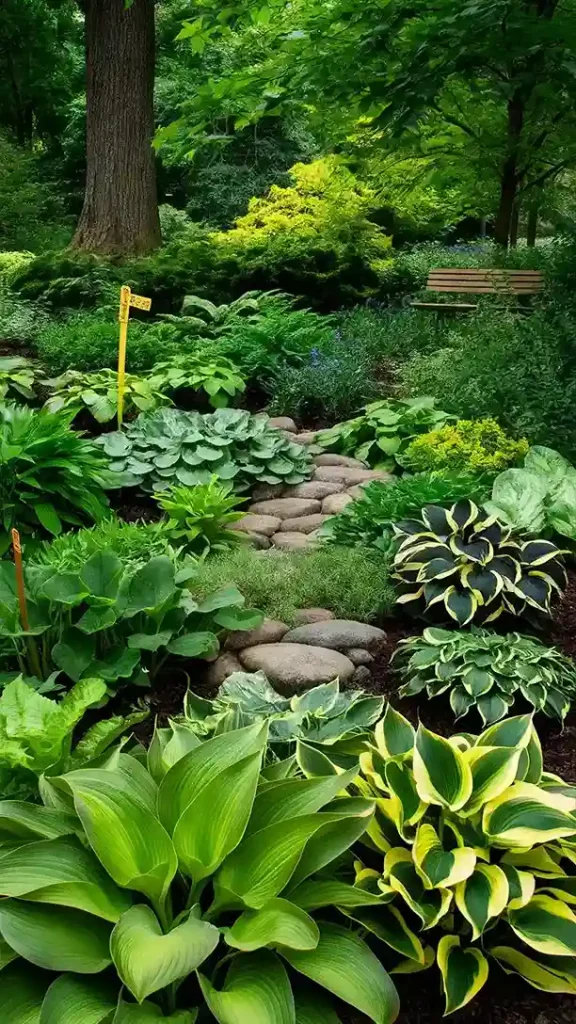
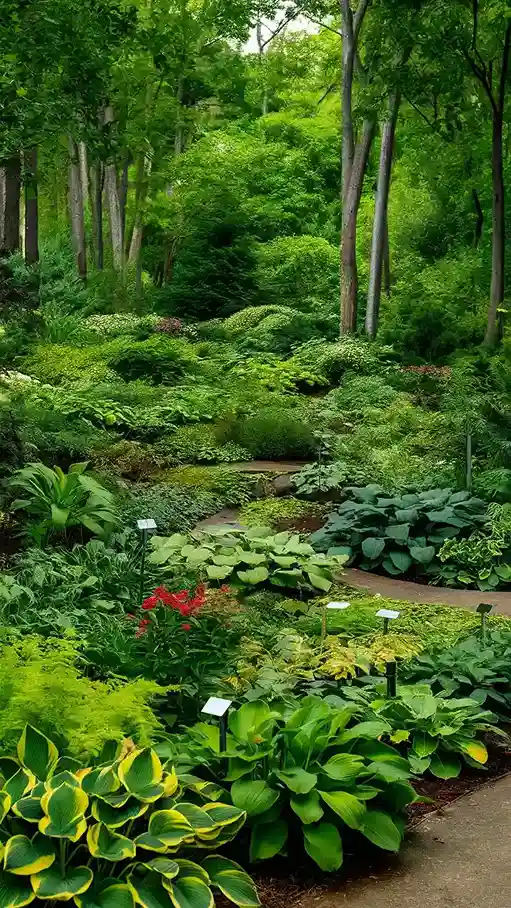
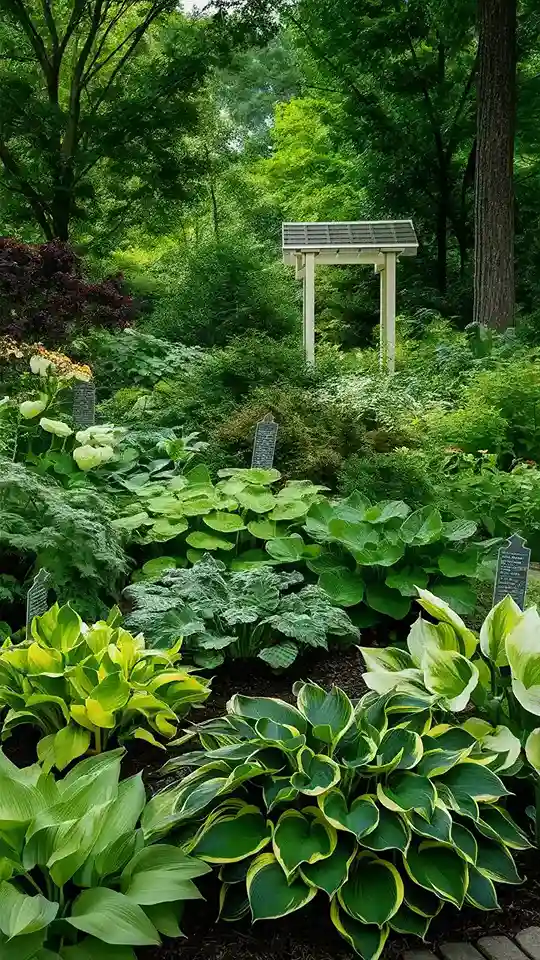
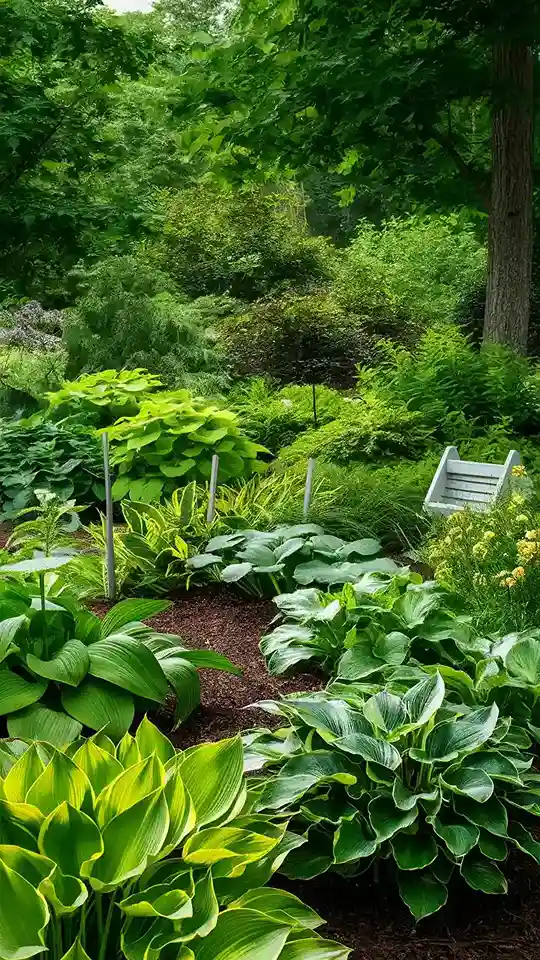
If you’re a true hosta enthusiast, dedicate a section of your garden to a hosta collection. This can become a personal botanical garden and a conversation starter for visitors.
Implementation
- Selection: Choose a wide variety of hostas with different colors, sizes, and textures. Consider rare or unusual varieties to make your collection unique.
- Layout: Organize the hostas in a well-planned layout, perhaps with labels, to showcase the diversity of this wonderful plant.
- Design: Create pathways and seating areas to allow for easy viewing and enjoyment of your hosta collection.
Maintenance
- Watering: Ensure consistent moisture, especially during dry spells.
- Mulching: Apply mulch to retain moisture and suppress weeds.
- Dividing: Divide hostas every few years to maintain their vigor and prevent overcrowding.
Conclusion
Hostas are incredibly versatile and can be used in a multitude of ways to enhance your garden. Whether you’re looking to create a serene shady retreat, a striking border, or a unique focal point, hostas have the potential to transform your landscape. Experiment with different varieties and combinations to find the perfect look for your outdoor space. Happy gardening!